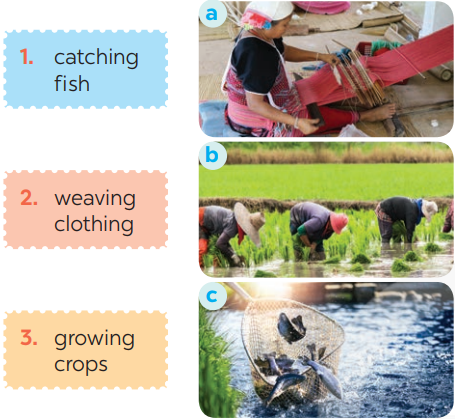Tiếng Anh 8 Unit 4 Skills 21. Match the phrases with the correct pictures. 2. Listen and tick (✓) the activities that minority children do to help their families. 3. Listen again and circle the correct answer A, B, or C. 4. Note five things you do to help your family. 5. Write a paragraph (80 - 100 words) about the things you do to help your family. Use the ideas in 4. GÓP Ý HAY - NHẬN NGAY QUÀ CHẤT Gửi góp ý cho HocTot.Nam.Name.Vn và nhận về những phần quà hấp dẫn
Lựa chọn câu để xem lời giải nhanh hơn
Bài 1 Video hướng dẫn giải Listening 1. Match the phrases with the correct pictures. (Ghép các cụm từ với các hình ảnh chính xác.)
Lời giải chi tiết: 1 – c. catching fish: bắt cá 2 – a. weaving clothing: dệt vải 3 – b. growing crops: trồng nông sản Bài 2 Video hướng dẫn giải 2. Listen and tick (✓) the activities that minority children do to help their families. (Nghe và đánh dấu (✓) những hoạt động mà trẻ em dân tộc thiểu số làm để giúp đỡ gia đình.)
Phương pháp giải: Bài nghe: Ethnic minority children might live the life different from that of most Kinh children. They spend some of their time helping their parents inside and outside the house. They learn to work from an early age, usually at six. Girls help look after the house, care for smaller children, weave clothing, and prepare food. Boys learn to do what their fathers do. They grow crops, raise the family's livestock, and catch fish. In the evening, the family often gathers round the open fire. Children listen to stories or legends of heroes from their grandparents. They also listen to adults talk about their work. This is how the elders pass on traditions and knowledge to their children. Nowadays, more and more minority children are going to school. There, they meet children from other ethnic groups. They play new games and learn new things. Tạm dịch: Trẻ em dân tộc thiểu số có thể sống cuộc sống khác với hầu hết trẻ em người Kinh. Họ dành thời gian của họ để giúp đỡ cha mẹ trong và ngoài nhà. Họ học cách làm việc từ khi còn nhỏ, thường là lúc sáu tuổi. Các bé gái giúp trông nhà, chăm sóc trẻ nhỏ, dệt quần áo và chuẩn bị thức ăn. Con trai học cách làm những việc mà cha các em ấy làm. Họ trồng trọt, chăn nuôi gia súc và đánh bắt cá. Buổi tối, gia đình thường quây quần cùng nhau bên bếp lửa hồng. Trẻ em lắng nghe những câu chuyện hoặc truyền thuyết về các anh hùng từ ông bà của mình. Các em cũng lắng nghe người lớn nói về công việc của họ. Đây là cách những người lớn tuổi truyền lại truyền thống và kiến thức cho con cháu của họ. Ngày nay, ngày càng có nhiều trẻ em dân tộc thiểu số được đến trường. Ở đó, các em được gặp những đứa trẻ từ những dân tộc khác. Họ chơi những trò chơi mới và học hỏi những điều mới từ nhau. Lời giải chi tiết:
Bài 3 Video hướng dẫn giải 3. Listen again and circle the correct answer A, B, or C. (Nghe lại và khoanh tròn câu trả lời đúng A, B hoặc C.) 1. Minority children usually learn to work at _____. (Trẻ em dân tộc thiểu số thường bắt đầu học làm việc từ khi _____.) A. twelve (12 tuổi) B. ten (10 tuổi) C. six (6 tuổi) 2. Girls _____. (Các bé gái _____. ) A. weave clothing (dệt vải) B. do the gardening (làm vườn) C. catch fish (bắt cá) 3. Boys _____. (Các bé trai _____.) A. prepare food (chuẩn bị thức ăn) B. raise livestock (chăn nuôi gia súc) C. do housework (làm việc nhà) 4. Children learn traditions through _____. (Trẻ em học về truyền thống thông qua _____.) A. work (công việc) B. music (âm nhạc) C. stories (câu chuyện) 5. The number of minority children going to school is _____. (Số lượng trẻ em dân tộc thiểu số đi học _____.) A. going up (tăng) B. going down (giảm) C. staying the same (giữ nguyên) Phương pháp giải: Bài nghe: Ethnic minority children might live the life different from that of most Kinh children. They spend some of their time helping their parents inside and outside the house. They learn to work from an early age, usually at six. Girls help look after the house, care for smaller children, weave clothing, and prepare food. Boys learn to do what their fathers do. They grow crops, raise the family's livestock, and catch fish. In the evening, the family often gathers round the open fire. Children listen to stories or legends of heroes from their grandparents. They also listen to adults talk about their work. This is how the elders pass on traditions and knowledge to their children. Nowadays, more and more minority children are going to school. There, they meet children from other ethnic groups. They play new games and learn new things. Tạm dịch: Trẻ em dân tộc thiểu số có thể sống cuộc sống khác với hầu hết trẻ em người Kinh. Họ dành thời gian của họ để giúp đỡ cha mẹ trong và ngoài nhà. Họ học cách làm việc từ khi còn nhỏ, thường là lúc sáu tuổi. Các bé gái giúp trông nhà, chăm sóc trẻ nhỏ, dệt quần áo và chuẩn bị thức ăn. Các bé trai học cách làm những việc mà cha các em ấy làm. Họ trồng trọt, nuôi gia súc và đánh bắt cá. Buổi tối, gia đình thường quây quần cùng nhau bên bếp lửa hồng. Trẻ em lắng nghe những câu chuyện hoặc truyền thuyết về các anh hùng từ ông bà của mình. Các em cũng lắng nghe người lớn nói về công việc của họ. Đây là cách những người lớn tuổi truyền lại truyền thống và kiến thức cho con cháu của họ. Ngày nay, ngày càng có nhiều trẻ em dân tộc thiểu số được đến trường. Ở đó, các em được gặp những đứa trẻ từ những dân tộc khác. Họ chơi những trò chơi mới và học hỏi những điều mới từ nhau. Lời giải chi tiết:
1. C Thông tin: They learn to work from an early age, usually at six. (Họ học cách làm việc từ khi còn nhỏ, thường là lúc sáu tuổi.) 2. A Thông tin: Girls help look after the house, care for smaller children, weave clothing... (Các bé gái giúp trông nhà, chăm sóc trẻ nhỏ, dệt quần áo...) 3. B Thông tin: Boys learn to do what their fathers do. They grow crops, raise the family's livestock... (Các bé trai học cách làm những việc mà cha các em ấy làm. Họ trồng trọt, nuôi vật nuôi...) 4. C Thông tin: Children listen to stories or legends of heroes from their grandparents. They also listen to adults talk about their work. This is how the elders pass on traditions and knowledge to their children. (Trẻ em lắng nghe những câu chuyện hoặc truyền thuyết về các anh hùng từ ông bà của mình. Các em cũng lắng nghe người lớn nói về công việc của họ. Đây là cách những người lớn tuổi truyền lại truyền thống và kiến thức cho con cháu của họ.) 5. A Thông tin: Nowadays, more and more minority children are going to school. (Ngày nay, ngày càng có nhiều trẻ em dân tộc thiểu số được đến trường.) Bài 4 Video hướng dẫn giải Writing 4. Note five things you do to help your family. (Viết ra năm điều bạn làm để giúp đỡ gia đình của bạn.) Lời giải chi tiết: - taking out the garbage (vứt rác) - tidying my bedroom (dọn phòng ngủ của tôi) - doing the washing up (rửa bát) - put away books and toys (cất sách và đồ chơi) - helping mother with cooking (giúp mẹ nấu ăn) Bài 5 Video hướng dẫn giải 5. Write a paragraph (80 - 100 words) about the things you do to help your family. Use the ideas in 4. (Viết đoạn văn (80 - 100 từ) kể về những việc em làm để giúp đỡ gia đình. Sử dụng các ý tưởng trong bài 4.)
Lời giải chi tiết: Though I don’t have much time at home, I try my best to do something to help my family. I take out the garbage, dust the room, make my bed and pick up books and toys that are lying on the floor. I also help my mother with cooking dinner and my family likes my food so much. Sometimes I ask my family members if they need help. If I have more time stay at home, I would love to help my family with more housework. Tạm dịch: Dù mình không có nhiều thời gian ở nhà, mình cố gắng làm gì đó để giúp đỡ gia đình. Mình nhặt rắc, quét dọn phòng, dọn giường và nhặt sách và đồ chơi nằm trên sàn nhà. Mình cũng giúp mẹ nấu đồ ăn tối và nhà mình rất thích món mình nấu. Đôi khi mình hỏi mọi người xem có cần giúp gì không. Nếu mình có nhiều thời gian ở nhà hơn, mình sẽ giúp gia đình việc nhà nhiều hơn.
Xem thêm
Bài mẫu 2
Bài mẫu 3
I learnt to share housework with other members of the family when I was seven or eight. I always start the day by tidying up my bed. Then I prepare breakfast for me and my brother. I usually help prepare dinner or do the washing afterwards. At the weekend, I usually spend an hour cleaning and tidying up my room and collecting dirty clothes of the whole family for washing. I sometimes do other work like planting vegetables or flowers on the top open floor of our house with my mother, repairing our bikes with my father, or repainting the gate. I think doing housework together connects our family's members. Tạm dịch: Tôi đã học cách chia sẻ việc nhà với các thành viên khác trong gia đình khi tôi lên bảy hoặc tám tuổi. Tôi luôn bắt đầu ngày mới bằng việc dọn dẹp giường ngủ. Sau đó, tôi chuẩn bị bữa sáng cho tôi và anh trai. Tôi thường giúp chuẩn bị bữa tối hoặc giặt giũ sau đó. Vào cuối tuần, tôi thường dành một giờ để dọn dẹp và sắp xếp phòng của mình và thu gom quần áo bẩn của cả gia đình để giặt. Đôi khi tôi làm những công việc khác như trồng rau hoặc hoa trên tầng cao nhất của ngôi nhà với mẹ, sửa xe đạp với bố hoặc sơn lại cổng. Tôi nghĩ rằng việc cùng nhau làm việc nhà sẽ gắn kết các thành viên trong gia đình. As a member of my family, I help my family by throwing away your garbage, dusting all the rooms, picking up books and toys and asking other family members if they need help. My parents do a lot of work for us. It is our fundamental duty to serve them back as a responsible family member by keeping our house clean, etc we can become helping hands for our parents which make us learn a lot of new things also and develop a sense of responsibility in us. Tạm dịch: Là một thành viên trong gia đình, mình giúp đỡ gia đình bằng cách vứt rác, lau bụi các phòng, nhặt sách và đồ chơi và hỏi các thành viên khác trong gia đình nếu họ cần giúp đỡ. Cha mẹ làm rất nhiều việc cho chúng ta, chúng ta có thể trở thành những người giúp đỡ cho cha mẹ, điều này khiến chúng ta học được nhiều điều mới và phát triển ý thức trách nhiệm trong chúng ta.
Xem thêm
Bài mẫu 2
Bài mẫu 3
>> Học trực tuyến lớp 8 trên Tuyensinh247.com. Đầy đủ khoá học các bộ sách: Kết nối tri thức với cuộc sống; Chân trời sáng tạo; Cánh diều. Cam kết giúp học sinh lớp 8 học tốt, hoàn trả học phí nếu học không hiệu quả. PH/HS tham khảo chi tiết khoá học tại: Link
|





















